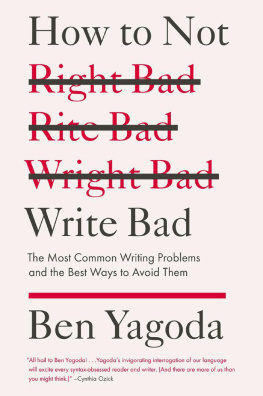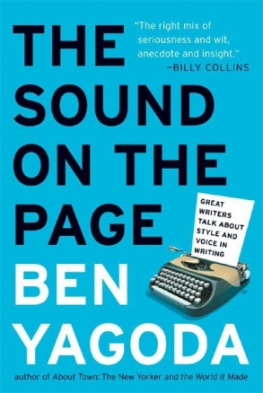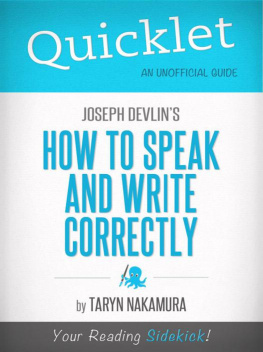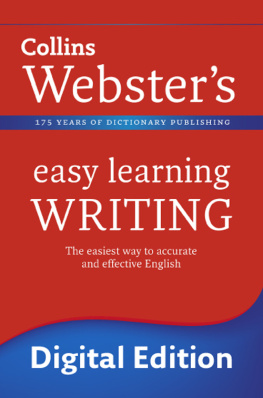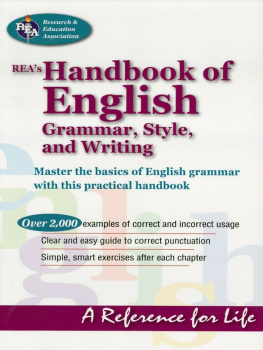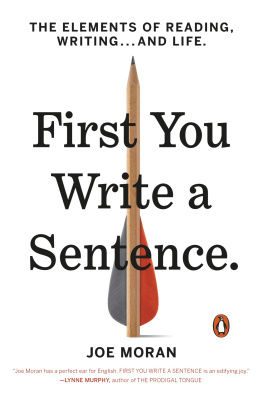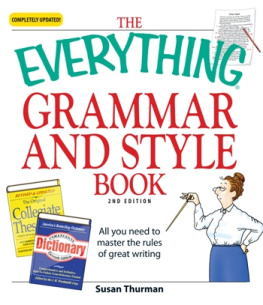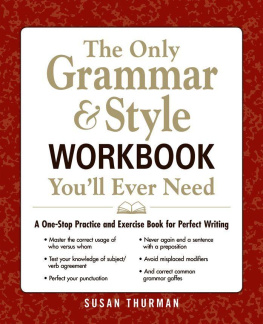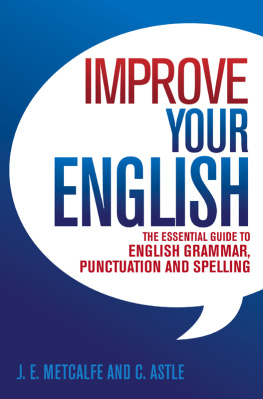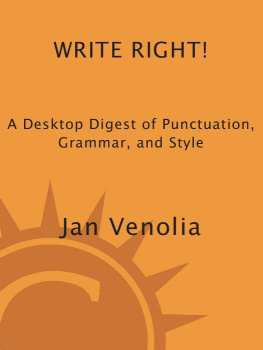How to Not
Write Bad
Also by Ben Yagoda
Memoir: A History
When You Catch an Adjective, Kill It:
The Parts of Speech, for Better and/or Worse
The Sound on the Page: Style and Voice in Writing
About Town: The New Yorker and the World It Made
Will Rogers: A Biography
The Art of Fact: A Historical Anthology of
Literary Journalism (coeditor)
All in a Lifetime: An Autobiography (with Ruth Westheimer)
How to Not
Write Bad

The Most Common
Writing Problems and
the Best Ways to
Avoid Them

BEN YAGODA
RIVERHEAD BOOKS
New York
RIVERHEAD BOOKS
Published by the Penguin Group
Penguin Group (USA) Inc.
375 Hudson Street, New York, New York 10014, USA
Penguin Group (Canada), 90 Eglinton Avenue East, Suite 700, Toronto, Ontario M4P 2Y3, Canada (a division of Pearson Penguin Canada Inc.) Penguin Books Ltd., 80 Strand, London WC2R 0RL, England Penguin Ireland, 25 St. Stephens Green, Dublin 2, Ireland (a division of Penguin Books Ltd.) Penguin Group (Australia), 707 Collins Street, Melbourne, Victoria 3008, Australia (a division of Pearson Australia Group Pty. Ltd.) Penguin Books India Pvt. Ltd., 11 Community Centre, Panchsheel Park, New Delhi110 017, India Penguin Group (NZ), 67 Apollo Drive, Rosedale, Auckland 0632, New Zealand (a division of Pearson New Zealand Ltd.) Penguin Books (South Africa), Rosebank Office Park, 181 Jan Smuts Avenue, Parktown North 2193, South Africa Penguin China, B7 Jiaming Center, 27 East Third Ring Road North, Chaoyang District, Beijing 100020, China
Penguin Books Ltd., Registered Offices: 80 Strand, London WC2R 0RL, England
The publisher does not have any control over and does not assume any responsibility for author or third-party websites or their content.
Copyright 2013 by Ben Yagoda
Cover design by Alex Merto
Book design by Tiffany Estreicher
All rights reserved.
No part of this book may be reproduced, scanned, or distributed in any printed or electronic form without permission. Please do not participate in or encourage piracy of copyrighted materials in violation of the authors rights. Purchase only authorized editions.
RIVERHEAD is a registered trademark of Penguin Group (USA) Inc.
The RIVERHEAD logo is a trademark of Penguin Group (USA) Inc.
First Riverhead trade paperback edition: February 2013
ISBN: 978-1-101-60212-6
Library of Congress Cataloging-in-Publication Data
Yagoda, Ben.
How to Not Write Bad / Ben Yagoda.First Riverhead edition.
pages cm
1. English languageRhetoricHandbooks, manuals, etc. 2. Report writingHandbooks, manuals, etc. 3. English languageGrammarHandbooks, manuals, etc. I. Title.
PE1408.Y34 2013
808.042dc23 2012043126

To David Friedman
with thanks for being in my corner all these years
CONTENTS
INTRODUCTION
Why a book on how to not write bad (or badly, if you insist)?
Im glad you asked. Simply put, this is a crucial and seriously underrepresented county in the Alaska-size state of books about writing. From the all-time champ, Strunk and Whites The Elements of Style, through more touchy-feely works like Anne Lamotts Bird by Bird, texts on this subject virtually all have the same goal. Sometimes its implicit, and sometimes its right there in the title, as in William Zinssers classic guide, On Writing Well.
That emphasis is fine, but it has its limitations. In a way, it reminds me of the vanity sizing favored by the apparel industrythe custom of labeling thirty-four-inch-waist pants as thirty-two so as to make customers feel good about themselves (and buy that companys pant, needless to say). I have spent the last twenty years teaching advanced journalism and writing classes in a selective university, and the majority of my (bright) students put me in mind of what Jack Nicholson famously shouted to Tom Cruise in A Few Good Men. The Cruise character couldnt handle the truth, Nicholson said. Well, most students, Ive found, cant handle writing well. At this point in their writing lives, that goal is simply too ambitious.
Its not just my students, either. My colleagues at various institutions say they encounter the same problems I do. And Ive run into these issues when Ive taught workshops all over the country and, of course, in that new and universal forum for written expression of every conceivable kind, the Internet.
You can certainly understand why people would want to aim high, especially in the United States, where self-esteem is fed to toddlers along with their Cheerios, and all the children are apparently above average. But you have to crawl before you walk, and walk before you run. And you have to be able to put together a clear and at least borderline graceful sentence, and to link that sentence with another one, before you can expect to make like David Foster Wallace.
In the 1950s, the British psychoanalyst Donald Winnicott coined the term good-enough mother (now more commonly and equitably expressed as good-enough parent). Its proved to be an enduring and very useful concept, referring to mothers and fathers who dont have superpowers, who cant solve every problem and address every need of their children, who make mistakes, but who provide a level of attention, concern, and care that may seem merely adequate but that turns out to do the job quite well. What Im talking about here is good-enough writing. As with parenting, it isnt necessarily easy to achieve, but its definitely achievable. And its a decidedly worthwhile goal.
* * *
Words are the building blocks of sentences, and sentences are the building blocks of any piece of writing; consequently, I focus on these basics. As far as Im concerned, not-writing-badly consists of the ability, first, to craft sentences that are correct in terms of spelling, diction (that is, word choice), punctuation, and grammar, and that display clarity, precision, and grace. Once thats mastered, there are a few more areas that have to be addressed in crafting a whole paragraph: cadence, consistency of tone, word repetition, transitions between sentences, paragraph length. And thats all there is to it! (I know, I know, thats plenty.)
Ive mentioned my students but this book isnt just for classroom use. Its for everyone who wants to improve his or her prose. Let me be more precise. The best way to measure or think about the badness of a sentence, or an entire piece of writing, is to imagine the effect it has on someone who reads it. This could be a teacher or professor; an editor whos deciding whether to publish it in a magazine; a hypothetical person out in cyberspace who has just come upon a new blog post; or a coworker confronted with an interoffice memo. In all cases, bad writing will induce boredom, annoyance, incomprehension, and/or daydreaming. The less bad it is, the more that real or imaginary soul will experience the text as clear, readable, persuasive, and, in the best case, pleasing. And the more that reader will keep on reading.
Next page
